Monitoring Groundwater Thermal Treatment Using a Fiber-Optic Distributed Temperature Sensing Network
Abstract
1. Introduction
2. Materials and Methods
2.1. Principles of DTS
2.2. Thermal Groundwater Remediation
2.3. DTS Installation and Data Processing
3. Results
4. Discussion
5. Conclusions
Supplementary Materials
Author Contributions
Funding
Data Availability Statement
Acknowledgments
Conflicts of Interest
References
- Suárez, F.; Hausner, M.B.; Dozier, J.; Selker, J.S.; Tyler, S.W. Heat transfer in the environment: Development and use of fiber-optic distributed temperature sensing. In Developments in Heat Transfer; IntechOpen: London, UK, 2011. [Google Scholar]
- Tyler, S.W.; Selker, J.S.; Van de Giesen, N.; Bogaard, T.; Aguilar-López, J. Distributed Fiber-Optic Hydrogeophysics; The Groundwater Project: Guelph, ON, Canada, 2022. [Google Scholar] [CrossRef]
- Briggs, M.A.; Lautz, L.K.; McKenzie, J.M.; Gordon, R.P.; Hare, D.K. Using high-resolution distributed temperature sensing to quantify spatial and temporal variability in vertical hyporheic flux. Water Resour. Res. 2012, 48. [Google Scholar] [CrossRef]
- Westhoff, M.C.; Savenije, H.H.G.; Luxemburg, W.M.J.; Stelling, G.S.; van de Giesen, N.C.; Selker, J.S.; Pfister, L.; Uhlenbrook, S. A distributed stream temperature model using high resolution temperature observations. Hydrol. Earth Syst. Sci. 2007, 11, 1469–1480. [Google Scholar] [CrossRef]
- Selker, J.S.; Thevenaz, L.; Huwald, H.; Mallet, A.; Luxemburg, W.; Van De Giesen, N.; Stejskal, M.; Zeman, J.; Westhoff, M.; Parlange, M.B. Distributed fiber-optic temperature sensing for hydrologic systems. Water Resour. Res. 2006, 42. [Google Scholar] [CrossRef]
- Read, T.; Bour, O.; Selker, J.S.; Bense, V.F.; Borgne, T.L.; Hochreutener, R.; Lavenant, N. Active-distributed temperature sensing to continuously quantify vertical flow in boreholes. Water Resour. Res. 2014, 50, 3706–3713. [Google Scholar] [CrossRef]
- Freifeld, B.M.; Finsterle, S.; Onstott, T.C.; Toole, P.; Pratt, L.M. Ground surface temperature reconstructions: Using in situ estimates for thermal conductivity acquired with a fiber-optic distributed thermal perturbation sensor. Geophys. Res. Lett. 2008, 35. [Google Scholar] [CrossRef]
- Patterson, J.R.; Cardiff, M.; Coleman, T.; Wang, H.; Feigl, K.L.; Akerley, J.; Spielman, P. Geothermal reservoir characterization using distributed temperature sensing at Brady Geothermal Field, Nevada. Lead. Edge 2017, 36, 1024a1–1024a7. [Google Scholar] [CrossRef]
- Coleman, T.I.; Parker, B.L.; Maldaner, C.H.; Mondanos, M.J. Groundwater flow characterization in a fractured bedrock aquifer using active DTS tests in sealed boreholes. J. Hydrol. 2015, 528, 449–462. [Google Scholar] [CrossRef]
- Maldaner, C.H.; Munn, J.D.; Coleman, T.I.; Molson, J.W.; Parker, B.L. Groundwater flow quantification in fractured rock boreholes using active distributed temperature sensing under natural gradient conditions. Water Resour. Res. 2019, 55, 3285–3306. [Google Scholar] [CrossRef]
- Hartog, A.H. An Introduction to Distributed Optical Fibre Sensors; CRC Press: Boca Raton, FL, USA, 2017. [Google Scholar] [CrossRef]
- Bense, V.F.; Read, T.; Bour, O.; Le Borgne, T.; Coleman, T.; Krause, S.; Chalari, A.; Mondanos, M.; Ciocca, F.; Selker, J.S. Distributed Temperature Sensing as a downhole tool in hydrogeology. Water Resour. Res. 2016, 52, 9259–9273. [Google Scholar] [CrossRef]
- Hausner, M.B.; Suarez, F.; Glander, K.E.; van de Giesen, N.; Selker, J.S.; Tyler, S.W. Calibrating Single-Ended Fiber-Optic Raman Spectra Distributed Temperature Sensing Data. Sensors 2011, 11, 10859–10879. [Google Scholar] [CrossRef]
- Tyler, S.W.; Selker, J.S.; Hausner, M.B.; Hatch, C.E.; Torgersen, T.; Thodal, C.E.; Schladow, S.G. Environmental temperature sensing using Raman spectra DTS fiber-optic methods. Water Resour. Res. 2009, 45. [Google Scholar] [CrossRef]
- Munholland, J.; Rosso, D.; Randhawa, D.; Divine, C.; Pennington, A. Advances in Low-Temperature Thermal Remediation. In Advances in the Characterisation and Remediation of Sites Contaminated with Petroleum Hydrocarbons; García-Rincón, J., Gatsios, E., Lenhard, R.J., Atekwana, E.A., Naidu, R., Eds.; Springer International Publishing: Cham, Switzerland, 2024; pp. 623–653. [Google Scholar] [CrossRef]
- Divine, C.; Munholland, J.; Justicia-Leon, S.; Vidonish Aspinall, J.; Zardouzian, E.; Falta, R.; Freedman, D.; Becker, M. Final Report: Thermal In-Situ Sustainable Remediation (TISR®) to Enhance Biotic and Abiotic Reactions and Accelerate Remediation Timeframes; (ER20-5028); Arcadis Office of the Deputy Assistant Secretary of Defense (Energy Resilience & Optimization): Irvine, CA, USA, 2025; p. 351. [Google Scholar]
- des Tombe, B.F.; Bakker, M.; Smits, F.; Schaars, F.; van der Made, K.-J. Estimation of the Variation in Specific Discharge Over Large Depth Using Distributed Temperature Sensing (DTS) Measurements of the Heat Pulse Response. Water Resour. Res. 2019, 55, 811–826. [Google Scholar] [CrossRef]
- Medina, R.; Pham, C.; Plumlee, M.H.; Hutchinson, A.; Becker, M.W.; O’Connell, P.J. Distributed Temperature Sensing to Measure Infiltration Rates Across a Groundwater Recharge Basin. Groundwater 2020, 58, 913–923. [Google Scholar] [CrossRef] [PubMed]
- Becker, M.W.; Bauer, B.; Hutchinson, A. Measuring Artificial Recharge with Fiber Optic Distributed Temperature Sensing. Groundwater 2013, 51, 670–678. [Google Scholar] [CrossRef] [PubMed]
- Kobs, S.; Hausner, M. CTEMPs MATLAB DTS Toolbox User Guide; Center for Transformative Environmental Monitoring Programs (ctemps.org): Corvallis, OR, USA, 2015. [Google Scholar]
- Becker, M.; Georgian, T.; Ambrose, H.; Siniscalchi, J.; Fredrick, K. Estimating flow and flux of ground water discharge using water temperature and velocity. J. Hydrol. 2004, 296, 221–233. [Google Scholar] [CrossRef]
- Hawkins, A.J.; Fox, D.B.; Becker, M.W.W.; Tester, J.W. Measurement and simulation of heat exchange in fractured bedrock using inert and thermally degrading tracers. Water Resour. Res. 2017, 53, 1210–1230. [Google Scholar] [CrossRef]
- Hawkins, A.J.; Fox, D.B.; Koch, D.L.; Becker, M.W.; Tester, J.W. Predictive Inverse Model for Advective Heat Transfer in a Short-circuited Fracture: Dimensional Analysis, Machine Learning, and Field Demonstration. Water Resour. Res. 2020, 56, e2020WR027065. [Google Scholar] [CrossRef]
- Anderson, M.P. Heat as a ground water tracer. Groundwater 2005, 43, 951–968. [Google Scholar] [CrossRef] [PubMed]

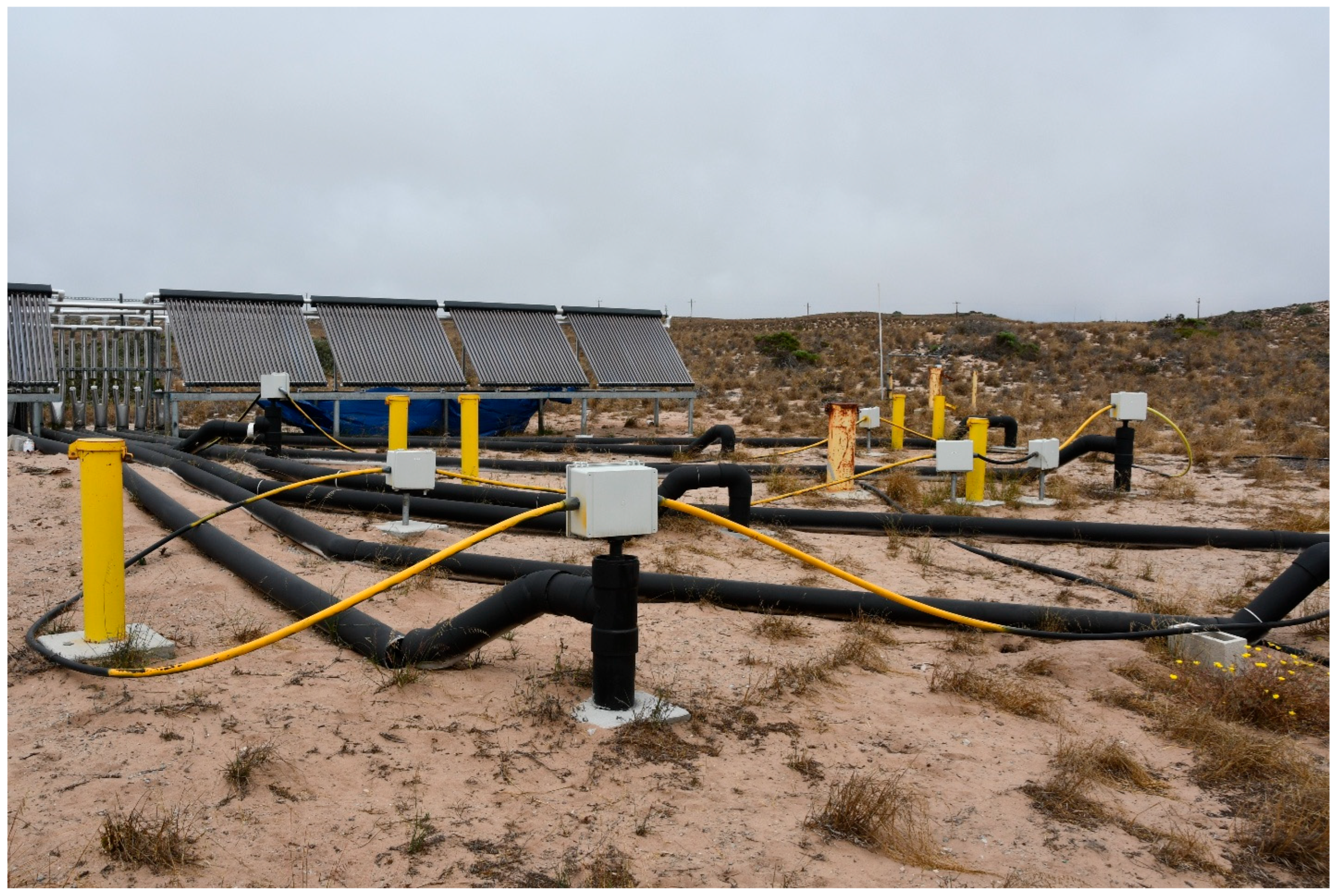
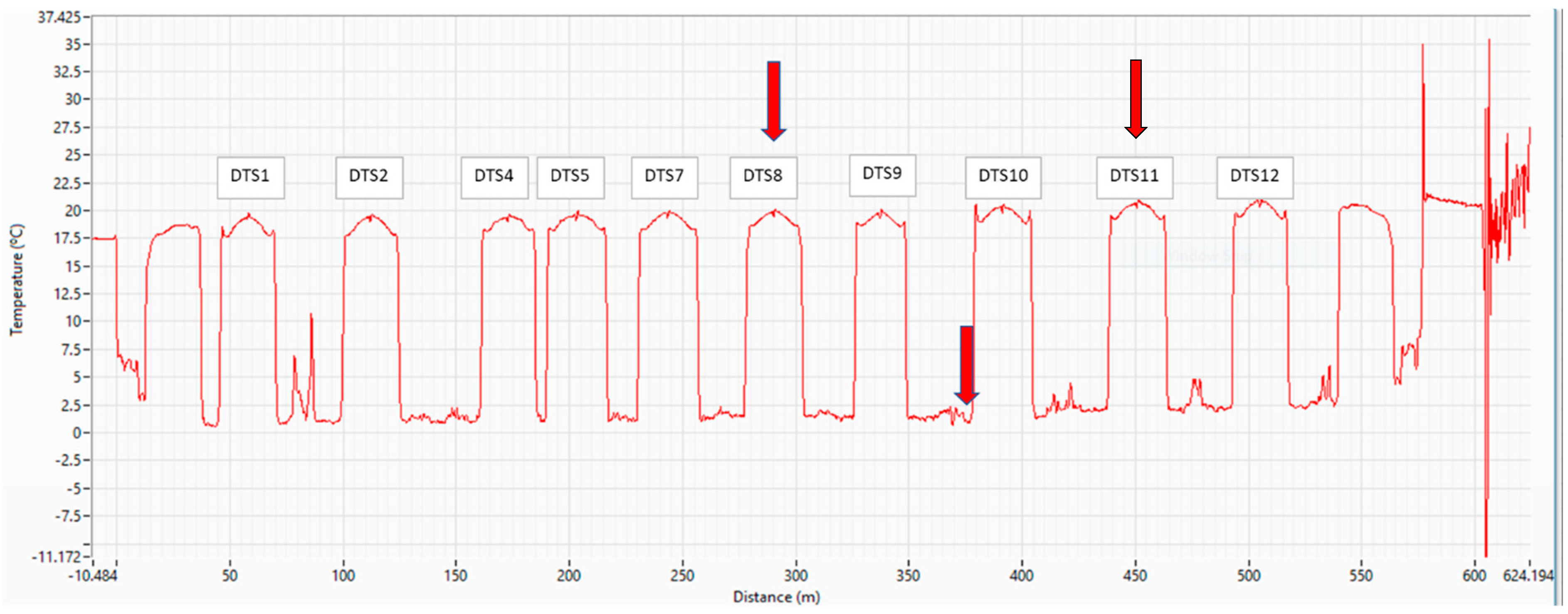
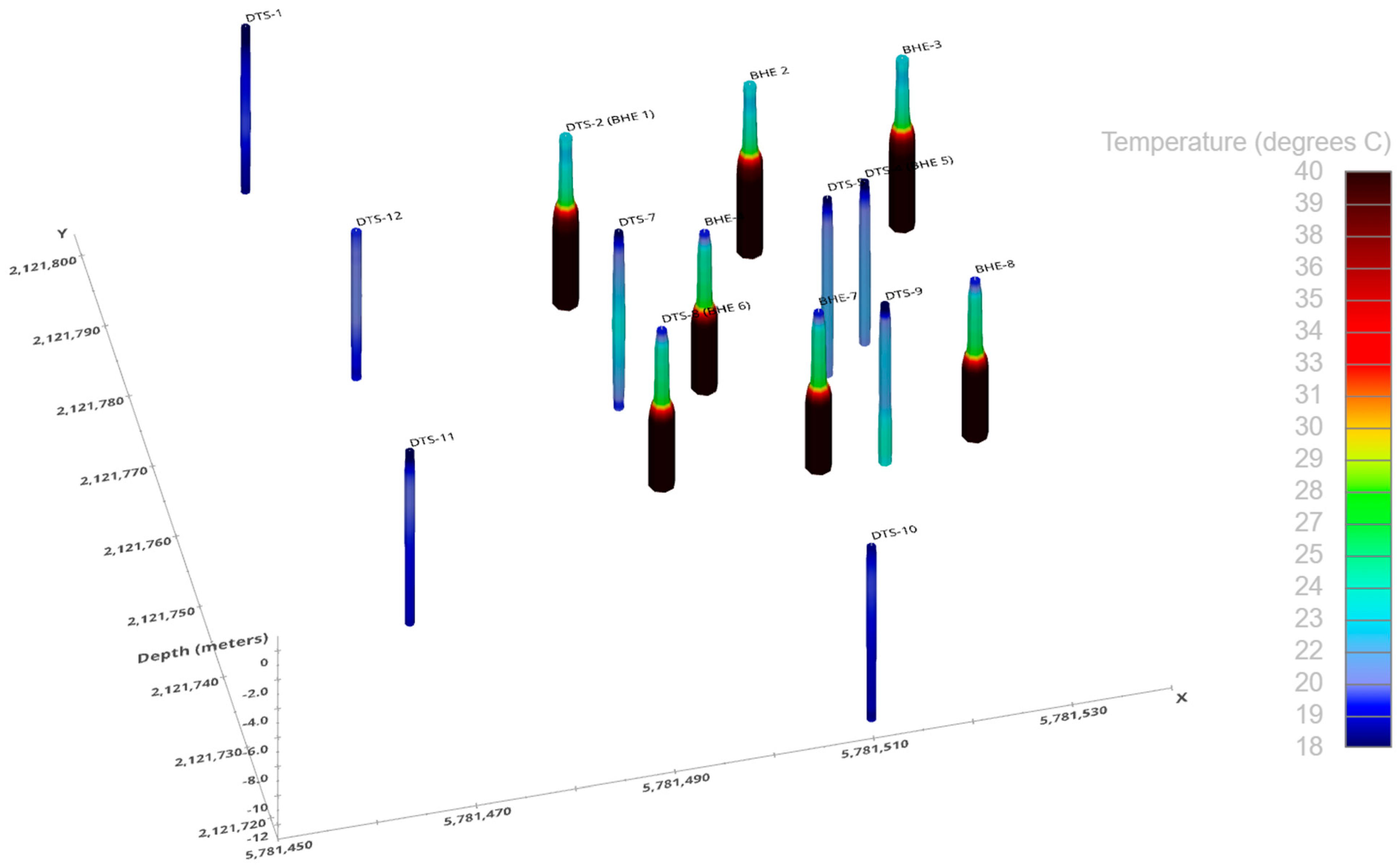
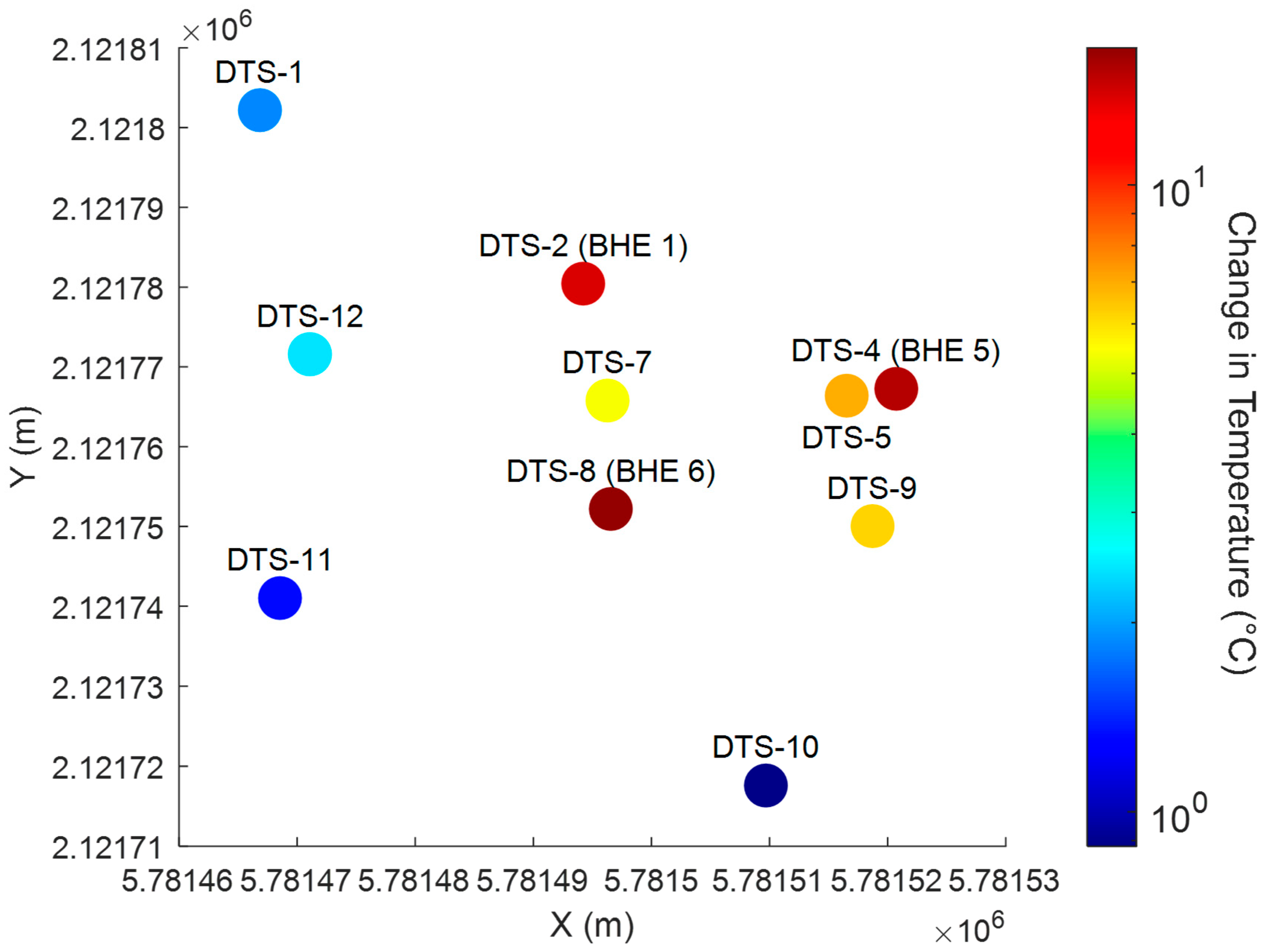
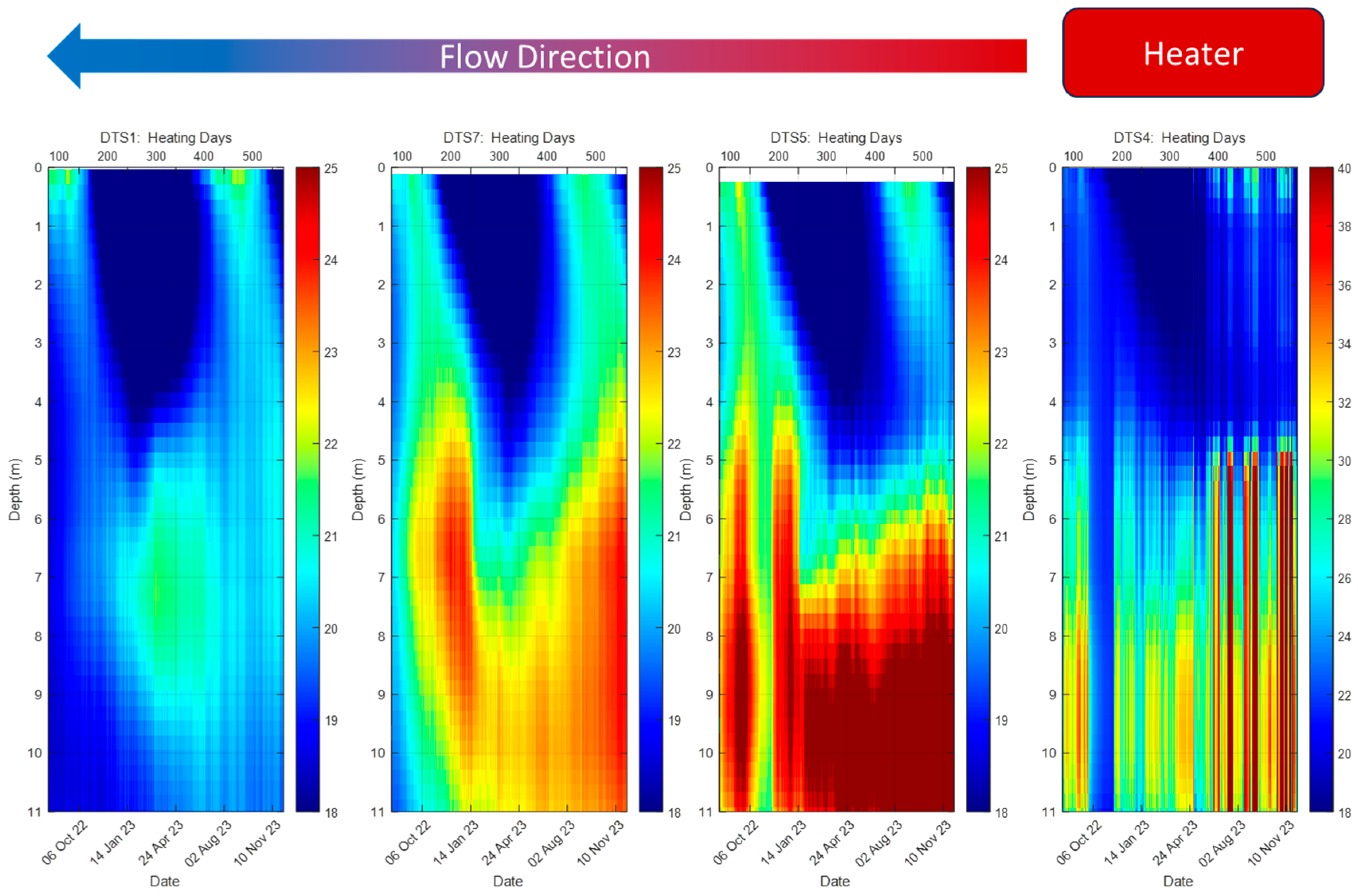
Disclaimer/Publisher’s Note: The statements, opinions and data contained in all publications are solely those of the individual author(s) and contributor(s) and not of MDPI and/or the editor(s). MDPI and/or the editor(s) disclaim responsibility for any injury to people or property resulting from any ideas, methods, instructions or products referred to in the content. |
© 2025 by the authors. Licensee MDPI, Basel, Switzerland. This article is an open access article distributed under the terms and conditions of the Creative Commons Attribution (CC BY) license (https://creativecommons.org/licenses/by/4.0/).
Share and Cite
Becker, M.W.; Cason, F.; Ward-Baranyay, M.; Divine, C.; Munholland, J.; Zardouzian, E. Monitoring Groundwater Thermal Treatment Using a Fiber-Optic Distributed Temperature Sensing Network. Sensors 2025, 25, 7105. https://doi.org/10.3390/s25237105
Becker MW, Cason F, Ward-Baranyay M, Divine C, Munholland J, Zardouzian E. Monitoring Groundwater Thermal Treatment Using a Fiber-Optic Distributed Temperature Sensing Network. Sensors. 2025; 25(23):7105. https://doi.org/10.3390/s25237105
Chicago/Turabian StyleBecker, Matthew W., Francine Cason, Megan Ward-Baranyay, Craig Divine, Jonah Munholland, and Erik Zardouzian. 2025. "Monitoring Groundwater Thermal Treatment Using a Fiber-Optic Distributed Temperature Sensing Network" Sensors 25, no. 23: 7105. https://doi.org/10.3390/s25237105
APA StyleBecker, M. W., Cason, F., Ward-Baranyay, M., Divine, C., Munholland, J., & Zardouzian, E. (2025). Monitoring Groundwater Thermal Treatment Using a Fiber-Optic Distributed Temperature Sensing Network. Sensors, 25(23), 7105. https://doi.org/10.3390/s25237105





